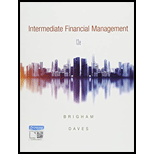
Concept explainers
Case summary:
Company S is considering adding a new line to its product mix and the production line would be set up in unused space in the main plant. It has installed machinery which generates the incremental sales of $1,250 units per year.
Due to this the sale price and cost prices are increased by 3% and firm’s net working capital would have to rise by an amount equivalent to 12% of sales revenues.
To discuss: Meaning of “risk” in the sense of capital budgeting and whether the risk can be quantified, if quantified, whether the quantification should be based on statistical analysis of historical data or on judgemental or subjective estimates.
Want to see the full answer?
Check out a sample textbook solution
Chapter 13 Solutions
Bundle: Intermediate Financial Management, 13th + MindTap Finance, 1 term (6 months) Printed Access Card
- Energy Resources generated an EPS of $4.38 over the last 12 months. The company's earnings are expected to grow by 30.7% next year, and because there will be no significant change in the number of shares outstanding, EPS should grow at about the same rate. You feel the stock should trade at a P/E of around 30 times earnings. Use the P/E approach to set a value on this stock. Using the P/E approach, the value on this stock is $ (Round to the nearest cent.)arrow_forwardThe Anderson Company has a net profits of $20 million, sales of $226 million, and 3.9 million shares of common stock outstanding. The company has total assets of $139 million and total stockholders' equity of $74 million. It pays $2.31 per share in common dividends, and the stock trades at $40 per share. Given this information, determine the following: a. Anderson's EPS. b. Anderson's book value per share and price-to-book-value ratio. c. The firm's P/E ratio. d. The company's net profit margin. e. The stock's dividend payout ratio and its dividend yield. f. The stock's PEG ratio, given that the company's earnings have been growing at an average annual rate of 8.2%. a. Anderson's EPS is $ (Round to the nearest cent.)arrow_forwardDavis Industries must choose between a gas-powered and an electric-powered forklift truck for moving materials in its factory. Because both forklifts perform the same function, the firm will choose only one. (They are mutually exclusive investments.) The electric-powered truck will cost more, but it will be less expensive to operate; it will cost $23,000, whereas the gas-powered truck will cost $17,100. The cost of capital that applies to both investments is 11%. The life for both types of truck is estimated to be 6 years, during which time the net cash flows for the electric-powered truck will be $6,500 per year, and those for the gas-powered truck will be $4,750 per year. Annual net cash flows include depreciation expenses. Calculate the NPV and IRR for each type of truck, and decide which to recommend. Do not round intermediate calculations. Round the monetary values to the nearest dollar and percentage values to two decimal places. Electric-poweredforklift truck…arrow_forward
- A project has an initial cost of $45,000, expected net cash inflows of $9,000 per year for 11 years, and a cost of capital of 14%. What is the project's NPV? (Hint: Begin by constructing a time line.) Do not round intermediate calculations. Round your answer to the nearest cent.arrow_forwardA project has an initial cost of $45,000, expected net cash inflows of $9,000 per year for 11 years, and a cost of capital of 14%. What is the project's NPV? (Hint: Begin by constructing a time line.) Do not round intermediate calculations. Round your answer to the nearest cent.arrow_forwardimage is blurr please comment i will write values then solve.Please don't solve i mistakely posted blurr image. i will give unhelpful if answer is incorrect..arrow_forward
- image is blurr please comment i will write values then solve.Please don't solve i mistakely posted blurr image. i will give unhelpful if answer is incorrect..arrow_forwardYou are thinking of inving in Tikki's Torches, Inc. You have only the following information on the at year-end 2008: Net income0.000 Total debt 12.2 million Debt ratio 42% What is Tikki's ROE for 2008? a. 1.79% b. 10.14% c. 3.09% d. 4.26%arrow_forwardPlease don't sopve i mistakely posted blurr image. i will give unhelpful if answer is incorrect..arrow_forward
- Iarrow_forwardno solve with assumption data Please don't solve i mistakely posted blurr image. i will give unhelpful if answer is incorrect..arrow_forwardCrenshaw, Incorporated, is considering the purchase of a $367,000 computer with an economic life of five years. The computer will be fully depreciated over five years using the straight-line method. The market value of the computer will be $67,000 in five years. The computer will replace five office employees whose combined annual salaries are $112,000. The machine will also immediately lower the firm's required net working capital by $87,000. This amount of net working capital will need to be replaced once the machine is sold. The corporate tax rate is 22 percent. The appropriate discount rate is 15 percent. Calculate the NPV of this project. Note: Do not round intermediate calculations and round your answer to 2 decimal places, e.g., 32.16. NPV Answer is complete but not entirely correct. S 103,141.80arrow_forward
 Intermediate Financial Management (MindTap Course...FinanceISBN:9781337395083Author:Eugene F. Brigham, Phillip R. DavesPublisher:Cengage Learning
Intermediate Financial Management (MindTap Course...FinanceISBN:9781337395083Author:Eugene F. Brigham, Phillip R. DavesPublisher:Cengage Learning EBK CONTEMPORARY FINANCIAL MANAGEMENTFinanceISBN:9781337514835Author:MOYERPublisher:CENGAGE LEARNING - CONSIGNMENT
EBK CONTEMPORARY FINANCIAL MANAGEMENTFinanceISBN:9781337514835Author:MOYERPublisher:CENGAGE LEARNING - CONSIGNMENT Managerial AccountingAccountingISBN:9781337912020Author:Carl Warren, Ph.d. Cma William B. TaylerPublisher:South-Western College Pub
Managerial AccountingAccountingISBN:9781337912020Author:Carl Warren, Ph.d. Cma William B. TaylerPublisher:South-Western College Pub Financial Reporting, Financial Statement Analysis...FinanceISBN:9781285190907Author:James M. Wahlen, Stephen P. Baginski, Mark BradshawPublisher:Cengage Learning
Financial Reporting, Financial Statement Analysis...FinanceISBN:9781285190907Author:James M. Wahlen, Stephen P. Baginski, Mark BradshawPublisher:Cengage Learning Survey of Accounting (Accounting I)AccountingISBN:9781305961883Author:Carl WarrenPublisher:Cengage LearningPrinciples of Accounting Volume 2AccountingISBN:9781947172609Author:OpenStaxPublisher:OpenStax College
Survey of Accounting (Accounting I)AccountingISBN:9781305961883Author:Carl WarrenPublisher:Cengage LearningPrinciples of Accounting Volume 2AccountingISBN:9781947172609Author:OpenStaxPublisher:OpenStax College





